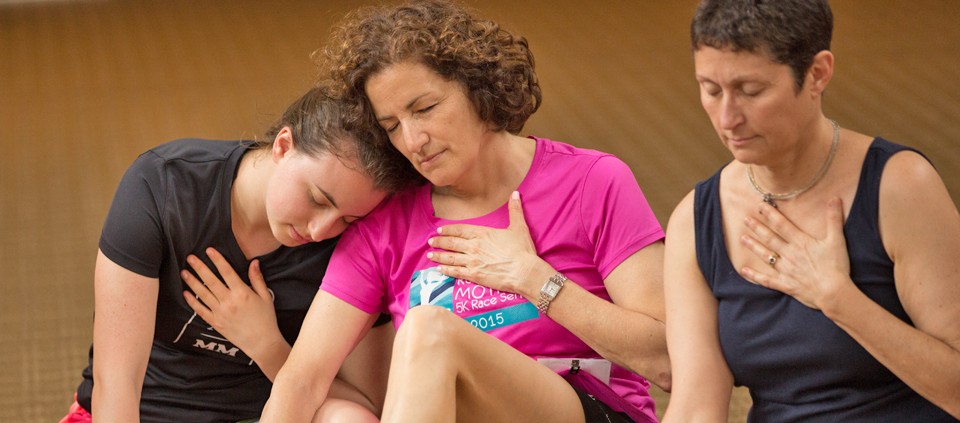Six Ways to Transmute Fear and Anger into Peace and Love This Year

by Shannon Sexton
Amid strife and chaos in our country and in the world at large, sacred chant master and teacher David Newman says, “It’s up to us to intensify our resolve to be beacons of love and ambassadors of peace.”
He says that it’s okay to have a healthy level of fear and anger about things that aren’t right in the world. It’s important to join protests, sign petitions, and call your representatives. But it’s also essential to find moments of contentment in the midst of chaos, to access “a state of being where everything is perfect as it is.”
Here are six ways to do that.
Meditate
Master teacher Sally Kempton, the author of Meditation for the Love of It, says that, through practices like meditation, “We can turn our fear and anger back into the heart and practice the type of awareness that allows those emotions to be transmuted into something positive,” such as compassion and a calm inner focus. When we inhabit that state of awareness, “the decisions we make about our relationships, our political situation, whatever volatility is coming up in our lives, all come from a much more centered place,” she says.
Daily meditation is a powerful way to use your inner focus to generate love and peace, Sally says. That can be as simple as sitting quietly for a few minutes and mentally repeating the words, “I breathe in peace, I breathe out love.” Or you can try a more advanced form of meditation: The Tibetan Buddhist practice known as tonglen can help transmute fear, anger, and other forms of suffering into peace and love.
Here’s how Sally teaches the practice.
Visualize Love and Activate Shakti
To get there, Sally suggests a visualization practice. Begin by asking yourself the question, “Is there any love present in this moment?” Then, “let your breath bring in even just the tiniest energy of love,” Sally says. “Feel it flowing in through your heart and your crown chakra and flow it through your body.”
Continue sitting with this feeling for a while, until you can sense what Sally describes as “a palpable pulsation.” In the yoga tradition, the name for this feeling is shakti, which Sally defines as “the subtle life-force energy that beats as your heart and flows as your breath. It’s the force that creates and empowers all life in the world. Focus on the pulsation of shakti for several minutes, and observe how your fear and anger dissipate.”
Find Inspiration in Satsanga
Through activities like satsanga (which David translates as “gathering in truth”), we can turn our attention away from anger and fear and “get clear about who we are and what our mission is,” he says. “And we can also get a dose of positivity, unity, and love.”
Traditionally, during a satsanga, spiritual aspirants sit at the feet of an enlightened teacher, listening to their words of wisdom and posing thoughtful questions. But satsanga can happen anytime two or more people are having a soul-searching, spiritually inspiring exchange, says David. “Whether you’re having a deep conversation with a friend in a coffee shop or on a train or at a yoga center, or sitting at the feet of the guru, time stands still and you’re transported into a space of lightness and joy and peace.” Then you move back into the world renewed.
Join a Kirtan Group
There’s a magnetic, healing force to the mantras, or sacred sounds, that we chant as a community during kirtan, David says. “These sounds are exalted by nature. They uplift us, and they exist at a higher level than the conflict we see all around us. The ancient yogic scripts say that we’re living in the Kali Yuga, a time of conflict and darkness, and the prescription is to utilize mantras like a life raft, to remember that darkness, pain, conflict, and confusion are not all there is. You go to the top of the mountain to breathe in the sweet air so that you can walk back down to the conflict and the controversy in the village in a state of equanimity.”
Develop a Clear Sense of Purpose and Service
David says that we need to dig deep to determine our role in bringing more beauty, love, and peace to the world. “How can we be the change we wish to see in the world? Having a clear sense of purpose and service enables us to feel empowered instead of powerless,” he says. “We begin to realize that whatever is happening in the world, we’re not separate from it. We’re a part of it.”
Treat the Words “Peace” and “Love” Like Mantras
David's moving single “Peace and Love” is all about choosing love over fear. “Some people can look at those words as trite or cliché, but right before I wrote this song, I had this childlike, awestruck moment when I experienced those words as mantras,” he says. “So I’ve trained myself to use those mantras all the time—when I greet someone, when I say goodbye. The song is a reminder to speak positively and communicate lovingly. Because what we think, and what we utter, creates our reality.”
Shannon Sexton is the former editor-in-chief of Yoga International magazine and a freelance writer, editor, and strategist.